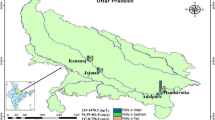Abstract
Since 1980, liver neoplasms in brown bullhead and polynuclear aromatic hydrocarbons (PAH) in sediment have been researched in a series of studies on the Black River in Lorain, Ohio. In the early 1980s the liver cancer prevalence in fish of age 3 and older was high, ranging from 22% to 39% of the adult population. These high cancer rates corresponded to high levels of PAHs in the sediment resulting from long-term releases by an upstream coking facility (USX). In 1983 this coking plant was closed, and by 1987 the PAH in sediment had declined by about two orders of magnitude. Coincidentally the tumor prevalence in 1987 was only about one-fourth of that in the early 1980s. In 1990, the most contaminated sediments were dredged. Neoplasm surveys in 1992 and 1993 found liver tumor frequencies in mature bullhead were as high as or higher than in the early 1980s. However liver tumor incidence declined in 1994, especially among age 3 fish, where neoplasm incidence was zero. These age 3 fish were the first group sampled that were not present during the 1990 dredging. These data are consistent with a hypothesis that the increase in tumor prevalence in 1992 and 1993 was caused by exposure to buried PAH-contaminated sediments released by the dredging. This research points out the insight provided by long term effects studies.
Similar content being viewed by others
References
Baumann, P.C.: 1992, ‘The Use of Tumors in Wild Populations of Fish to Assess Ecosystem Health’, J. Aquat. Ecosystem Health 1, 135–146.
Baumann, P.C., Harshbarger, J.C., and Hartman, K.L.: 1990, ‘Relationship Between Liver Tumors and Age in Brown Bullhead Populations from Two Lake Erie Tributaries’, Sci. Total Environ. 94, 71–87.
Baumann, P. C. and Harshbarger, J.C.: 1995, ‘Decline in Liver Neoplasms in Wild Brown Bullhead Catfish After Coking Plant Closes and Enviornmental PAHs Plummet’, Environ. Health Perspect. 2,168–170.
Baumann P. C., Smith, I.R., and Metcalfe, C.D.: 1996, ‘Linkages Between Chemical Contaminants and Tumors in Benthic Great Lakes Fish’, J. Great Lakes Res. 22, 131–152.
Baumann, P. C., Smith W.D., and Ribick, M.: 1982, ‘Hepatic Tumor Rates and Polynuclear Aromatic Hydrocarbon Levels in Two Populations of Brown Bullheads (Ictalurus nebulosus)’, In: M.W. Cooke, A.J. Dennis & G.L. Fisher (eds), Polynuclear Aromatic Hydrocarbons: Sixth International Symposium on Physical and Biological Chemistry, pp. 93–102. Battelle Press, Columbus, Ohio.
Black River Remedial Action Plan Coordinating Committee.: 1994, ‘Black River Remedial Action Plan Stage One Report: Impairment of Beneficial Uses of Pollution in the Black River Area of Concern’, Elyria, OH.
Fabacher, D.L, Schmitt, C.J., Besser, J.M., and Mac, M.J.: 1988, ‘Chemical Characterization and Mutagenic Properties of Polycyclic Aromatic Compounds in Sediment from Tributaries of the Great Lakes’, Environ. Toxicol. Chem., 7,529–543.
Harshbarger, J.C. and Clark, J.B.: 1990, ‘Epizootiology of Neoplasms in Bony Fish of North America’, Sci. Total Enviorn., 94,1–32.
Malins, D.C., McCain, B.B., Brown, D.W., Chan, S., Myers, M.S., Landahl, J.T., Prohaska, P.G., Friedman, A.J., Rhodes, L.D., Burrows, D.G., Gronlund W.D., and Hodgins, H.O.: 1984, ‘Chemical Pollutants in Sediments and Diseases of Bottom-Dwelling Fish in Puget Sound, Washington’, 18,75.
Myers, M.S., Landahl, J.T., Krahn, M.M., Johnson, L.L., and McCain, B.B.: 1990, ‘Overview of Studies on Liver Carcinogenesis in English Sole from Puget Sound; Evidence for a Xenobiotic Chemical Etiology I: Pathology and Epizootiology’, Sci. Total Environ. 94, 33–50.
Smith, S.B., Blouin, M.A., and Mac, M.J.: 1994.: ‘Ecological Comparisons of Lake Erie Tributaries with Elevated Incidence of Fish Tumors’, J. Great Lakes Res. 20,701–716.
Vogelbein, W.K., Fournie, J.W., Van Veld, P.A., and Huggett, R.J.: 1990, ‘Hepatic Neoplasms in the Mummichog Fundulus heteroclitus from a Creosote-Contaminanted Site’, Cancer Res., 50,5978–5986.
West, W.R., Smith, P.A., Stoker, P.W., Booth, G.M., Smith Oliver, T., Butterworth, B.E., and Lee, M.L.: 1985, ‘Analysis and Genotoxicity of a PAC-polluted River Sediment’. In: M. Cooke and J.D. Anthony, (eds), Polynuclear Aromatic Hydrocarbons-Mechanisms: Mechanisms, Methods and Metabolism, pp. 395–1411, Battelle Press, Columbus, OH.
Author information
Authors and Affiliations
Rights and permissions
About this article
Cite this article
Baumann, P.C., Harshbarger, J.C. Long Term Trends in Liver Neoplasm Epizootics of Brown Bullhead in the Black River, Ohio. Environ Monit Assess 53, 213–223 (1998). https://doi.org/10.1023/A:1005967631275
Issue Date:
DOI: https://doi.org/10.1023/A:1005967631275




